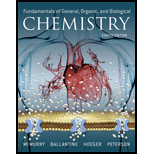
a)
Interpretation: Element from each pair of atoms that has the larger IE and high EA to be predicted.
Concept Introduction:
Ionization energy: The amount of energy required to remove an electron from the gaseous atom.
b)
Interpretation: Element that loses an electron more easily to be predicted.
Concept Introduction:
Ionization energy: The amount of energy required to remove an electron from the gaseous atom.
Electron Affinity: The amount of energy released when an electron is added to gaseous atom.
c)
Interpretation: Element that loses an electron more easily to be predicted.
Concept Introduction:
Ionization energy: The amount of energy required to remove an electron from the gaseous atom.
Electron Affinity: The amount of energy released when an electron is added to gaseous atom.
Want to see the full answer?
Check out a sample textbook solution
Chapter 3 Solutions
Pearson eText Fundamentals of General, Organic, and Biological Chemistry -- Instant Access (Pearson+)
- Arrange the elements Na, Si, and S in the order of(a) decreasing atomic radius.(h)increasing first ionization energy.arrow_forwardOxygen has 8 protons, 8 neutrons, and 8 electrons. What is its atomic mass?(a) 8 (b) 16 (c) 24 (d) 32.arrow_forwardWhile waiting at an airport, Neil Campbell once overheard this claim: "It's paranoid and ignorant to worry about industry or agriculture contaminating the environment with their chemical wastes. After all, this stuff is just made of the same atoms that were already present in our environment." Drawing on your knowledge of electron distribution, bonding, emergent properties, complete a short essay countering this argument. Match the words in the left column to the appropriate blanks in the sentences on the right. electrons electron distribution harm living organisms valence electrons charge distribution atoms basic atoms molecules electron shells interact with other molecules of each element have a characteristic number of The number of form, so the chemical reactivity of an atom arises from its emerge from the arrangement of their constituent atoms and of the bonds between them. The Thus, a wide variety of same determine its highly specific ability to Reset Help arranged in determines…arrow_forward
- ionic bonds involve_____ a)electrostatic attraction b)sharing electrons c)valence configurationarrow_forwardComplete the table below, using the diagram of an atom shown at right. name symbol 0 proton e Properties of subatomic particles charge (in multiples of e) 0 0 0 approximate mass (amu) (choose one) ✓ (choose one) ✓ 1.0 location on diagram (choose one) ✓ (choose one) ✓ A X A Sarrow_forwardLook up the valence electron configuration, covalent atomic radius, effective nuclear charge, first ionization energy and Pauling electronegativity in Chapter 8 (tables are attached). Examine the above data and answer the following questions. a) Explain why some of the elements like TI and Pb on the lower left of the p block are metallic. b) Explain why some of the elements like C, Si in the center of the p block form covalent bonds. Explain why these bonds formed by the network of these elements (as studied in Chapter 25) tend to be unreactive. c) Explain why the noble Group 8A elements are highly unreactive gases. d) Explain why some elements like F, CI, Br etc, on the upper right of the p block are highly reactive nonmetals.arrow_forward
- Write the electron configurations of Co, Co2+ , and Co3+.arrow_forwardApply the formula for the differences in electronegativities, for the following molecules, and define whether they are polar covalent, nonpolar covalent or ionic. Taking into account that: Non-polar covalent: greater than or equal to 0 but less than 0.7 Polar covalent: greater than or equal to 0.7 but less than 1.7 ionic: greater than 1.7 A)NO B)KCI C)F2 C)AsOarrow_forwardUse your copy of the periodic table to answer this question: If you add an electron to fluorine, what will result? A) a negatively charged anion B) a different atomic number C) a different isotope D) a different element E) a positively charged cationarrow_forward
- Which of the following elements would you expect to form (i) diatomic molecules, (ii) mainly covalent bonds, (iii) mainly ionic bonds, and (iv) both covalent and ionic bonds? (More than one answer may apply; rememberthat some nonmetals can form ionic bonds with metals.) Explain your answers.arrow_forwardThe atomic emission spectrum for a particular element includes blue-violet light with wavelength 440. nm. Calculate the energy in joules of this light given that E = h c/A, and h = 6.63 x 10-34Js, and c = 3.00 x 10°m/s. (h andc are constants, A is wavelength, convert nm into m) h c E =arrow_forwardThe distribution of electrons across the shells of sulphur (atomic number = 16) is as follows (number of shells indicated with Roman numbers: number of electrons shown with Arabic numbers) 1-8, 11-8 1-2; 11 -4: III - 4 (1-4; || - 4; ||| - 8 () 1-2; 11 - 6; III - 8 (1-2; 11 - 8; II - 6arrow_forward
 BiochemistryBiochemistryISBN:9781319114671Author:Lubert Stryer, Jeremy M. Berg, John L. Tymoczko, Gregory J. Gatto Jr.Publisher:W. H. Freeman
BiochemistryBiochemistryISBN:9781319114671Author:Lubert Stryer, Jeremy M. Berg, John L. Tymoczko, Gregory J. Gatto Jr.Publisher:W. H. Freeman Lehninger Principles of BiochemistryBiochemistryISBN:9781464126116Author:David L. Nelson, Michael M. CoxPublisher:W. H. Freeman
Lehninger Principles of BiochemistryBiochemistryISBN:9781464126116Author:David L. Nelson, Michael M. CoxPublisher:W. H. Freeman Fundamentals of Biochemistry: Life at the Molecul...BiochemistryISBN:9781118918401Author:Donald Voet, Judith G. Voet, Charlotte W. PrattPublisher:WILEY
Fundamentals of Biochemistry: Life at the Molecul...BiochemistryISBN:9781118918401Author:Donald Voet, Judith G. Voet, Charlotte W. PrattPublisher:WILEY BiochemistryBiochemistryISBN:9781305961135Author:Mary K. Campbell, Shawn O. Farrell, Owen M. McDougalPublisher:Cengage Learning
BiochemistryBiochemistryISBN:9781305961135Author:Mary K. Campbell, Shawn O. Farrell, Owen M. McDougalPublisher:Cengage Learning BiochemistryBiochemistryISBN:9781305577206Author:Reginald H. Garrett, Charles M. GrishamPublisher:Cengage Learning
BiochemistryBiochemistryISBN:9781305577206Author:Reginald H. Garrett, Charles M. GrishamPublisher:Cengage Learning Fundamentals of General, Organic, and Biological ...BiochemistryISBN:9780134015187Author:John E. McMurry, David S. Ballantine, Carl A. Hoeger, Virginia E. PetersonPublisher:PEARSON
Fundamentals of General, Organic, and Biological ...BiochemistryISBN:9780134015187Author:John E. McMurry, David S. Ballantine, Carl A. Hoeger, Virginia E. PetersonPublisher:PEARSON





